October 8. AKSUM "Discovering a 'New' Ancient Empire" Our first full day in Aksum went really well. We had breakfast at our hotel and then set out on foot to see the sites. We made a stop at the Ethiopian Air office to look into changing our flights again. With all of the hassles that we had been experiencing in Ethiopian we had grown weary and were 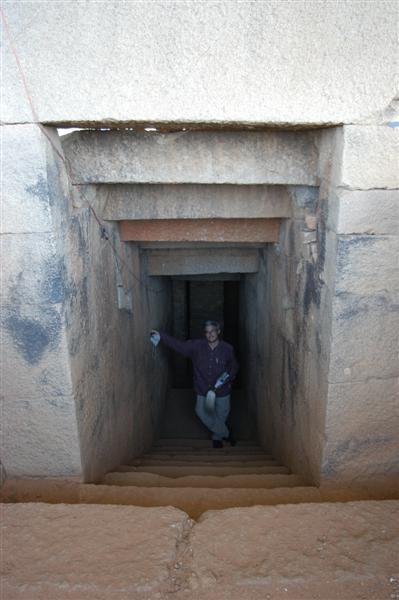 really considering skipping Mekele and heading off to the UAE sooner than planned. They told us it was possible but there weren't seats on the flight to Addis that we wanted. Again, we would have to come back later. really considering skipping Mekele and heading off to the UAE sooner than planned. They told us it was possible but there weren't seats on the flight to Addis that we wanted. Again, we would have to come back later.
Aksum has been called 'the last of the great civilizations of Antiquity to be revealed to modern knowledge', but you wouldn't know it to look at the town today. It is a completely unremarkable place. The well paved curb and gutter road through town was wider than traffic could possibly make use of and the buildings were mostly just concrete slab construction. Aksum was flat but hills rolled to the northern side of town. You would never know that the kingdom that once reigned from Aksum stretched across the Red Sea to encompass large parts of the Arabian peninsula and west into the Sudanese Nile Valley. The empire existed from AD 1 - 700 and was one of the most powerful kingdoms in the ancient world. Lying at the crossroads of important trading routes, the kingdom flourished for centuries. It was known to the Greeks, Romans, Byzantines and Arabs but only first entered European documentation in the 16th and 18th centuries. Today the area still remains 98% unexcavated!
We started our sightseeing at the Archeology Museum after running around a bit to find the ticket office. An Aksum ticket covered all sights in the town for several days. The office also sold certificates to show that you had completed a pilgrimage to the home of the Ark of the Covenant. After moving around the country for centuries the Ark of the Covenant supposedly rests in the St. Mary of Zion Church in Aksum. We had to get a certificate to add to our growing collection of bizarre accomplishments. At the museum we ran into the three teachers again and jumped in to listen to the tour they were being given. The guides English was very hard to understand and the museum was extremely modest for such an important h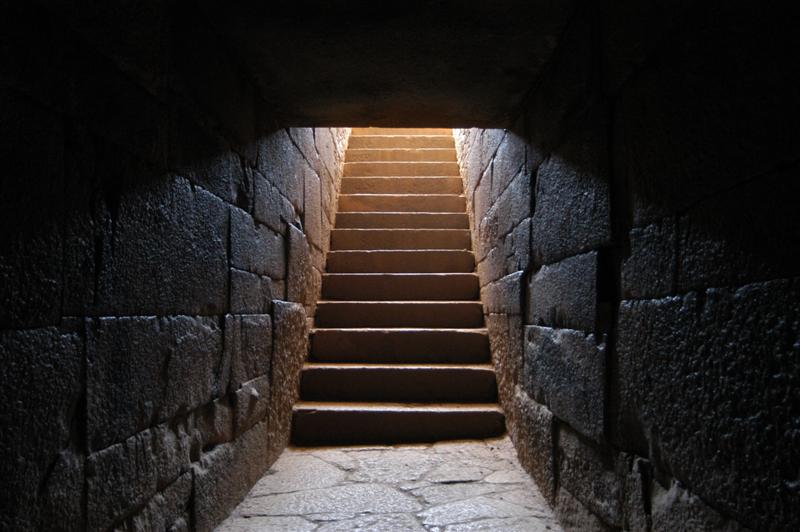 istorical site (only four small rooms) but it was a worthwhile start to the day. From there we continued on to the northern stelae field, just up the street. The teachers had already been to visit the stelae field but we decided to get together at the Yeha Hotel in late afternoon to watch the sunset together. istorical site (only four small rooms) but it was a worthwhile start to the day. From there we continued on to the northern stelae field, just up the street. The teachers had already been to visit the stelae field but we decided to get together at the Yeha Hotel in late afternoon to watch the sunset together.
The northern stelae field was Aksum's unrivaled archaeological highlight but still somehow smaller than I expected. It stood at the end of the street, just past St. Mary of Zion, and was enclosed with just a simple chain link fence. It was approaching midday so the weather was getting warm. We were the only people in the stelae field when we arrived but we were soon joined by a tour group. There were over 120 stelae, stone monoliths, standing or lying all over the field but just a couple of them had a detailed history to tell. Just as we came into the gate was the most noticeable of the stelae, King Ezana's stele, standing 24m high. The neatly carved Aksumite style made the stone monolith look more like a modern skyscraper rather than an ancient monument. Little windows were carved up and down the facade. The other mentionable stele was the Great Stele that would stand 33m high if it had ever been successfully erected but it wasn't. The massive stele lays on it's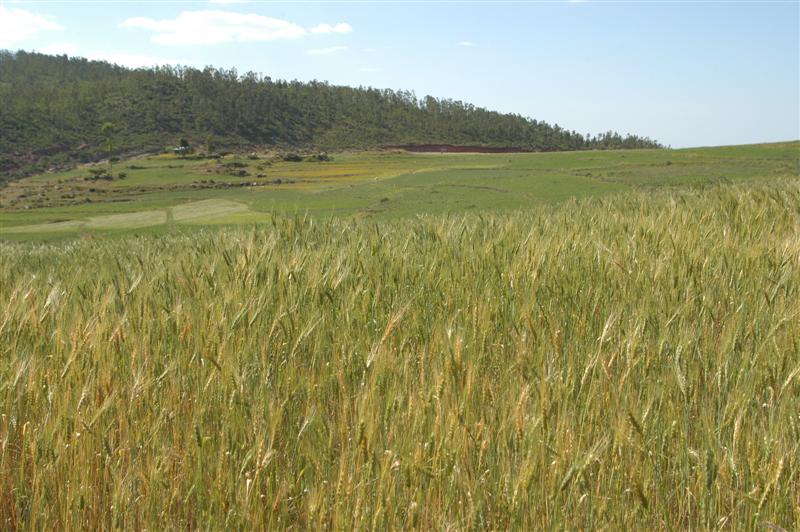 side, broken into large pieces. It is believed to have been the largest single block of stone that humans have ever tried to erect. Some suggest that the toppling of the Giant Stele in the 4th century contributed to people's conversion to Christianity, like a sign from God. The second largest stele erected under the Aksum was 25m high but it was shipped to Italy in 1937, during the Italian occupation, and stands in the Piazza di Porta Capena in Rome. It is supposed to be returned to Ethiopia but things are slow moving. side, broken into large pieces. It is believed to have been the largest single block of stone that humans have ever tried to erect. Some suggest that the toppling of the Giant Stele in the 4th century contributed to people's conversion to Christianity, like a sign from God. The second largest stele erected under the Aksum was 25m high but it was shipped to Italy in 1937, during the Italian occupation, and stands in the Piazza di Porta Capena in Rome. It is supposed to be returned to Ethiopia but things are slow moving.
The second most important remaining features of Aksum are the many tombs. We visited the small Tomb of the False Door inside the boundaries of the stelae field. Dating from the 4th century it was finely constructed and well preserved but nothing grand like the tombs of Egypt. We went up to the Yeha Hotel for a drink break before continuing the tomb part of our tour. Perched on a small hill it offered nice views across the field and Aksum. Outside the hotel we were hit up by tenacious souvenir salesmen. The day had been remarkably free of tourist related hassles but this hotel was the big tour group hotel. Leaving the Yeha Hotel we walked up the valley to the north of Aksum to visit two larger tombs, the tombs of the Kings Kaleb and Gebre Meskel. As we set out on the dirt road a couple of young girls came up to us and started begging persistently. We just kept going but an older boy nearby picked up a stone and was motioning to the girls to throw rocks at us. We had heard a couple of accounts of tourists having rocks thrown at them for not giving away money but, in this case, our serious looks told them they would regret it.
A caretaker opened the gate to the tombs for us but we were soon joined by a large tour group. Their imminent arrival was harkened by the earlier arrival of the same group of souvenir salesmen from outside the hotel. At first I was dumbfoun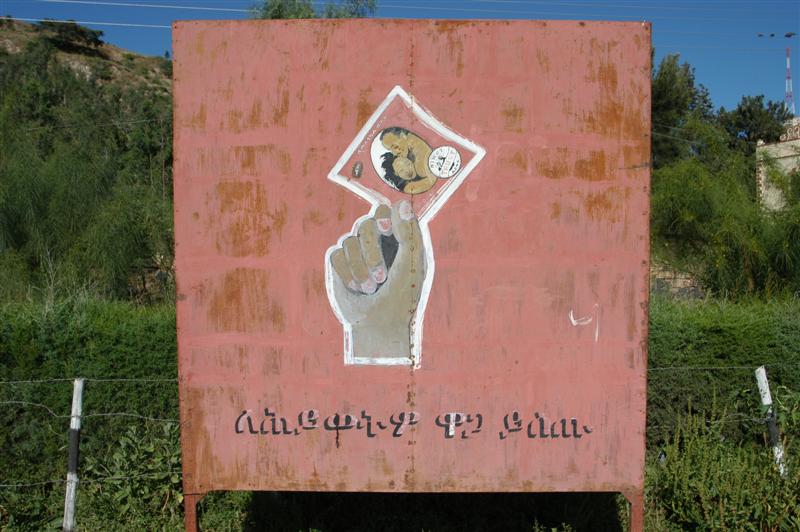 ded by their persistence but they assured us they were there for the tour group not to hassle us. We had just enough time to get through the two tombs before we were engulfed by a large German-speaking group. Long stairways led down into the tombs and their sheer size and state of preservation were impressive but neither took very long to see. The flowing tef fields made the walk out and back very pleasant. Naturally the souvenir touts did try to sell us stuff again but I just kept walking. Rob stopped to look at their fly whisks since he had given his away to another tourist but I still kept walking. They told him he was a nice man but had a very bad wife. ded by their persistence but they assured us they were there for the tour group not to hassle us. We had just enough time to get through the two tombs before we were engulfed by a large German-speaking group. Long stairways led down into the tombs and their sheer size and state of preservation were impressive but neither took very long to see. The flowing tef fields made the walk out and back very pleasant. Naturally the souvenir touts did try to sell us stuff again but I just kept walking. Rob stopped to look at their fly whisks since he had given his away to another tourist but I still kept walking. They told him he was a nice man but had a very bad wife.
On the way back into town we stopped at the shack covering the famous King Ezana's inscription. Just found in 1981 by a farmer and still standing in the same place. The inscription warned that if any person dared to move the tablet would meet an untimely death. The stone is like Ethiopia's Rosetta stone, carved on three sides in three different scripts; Sabaean (a Semitic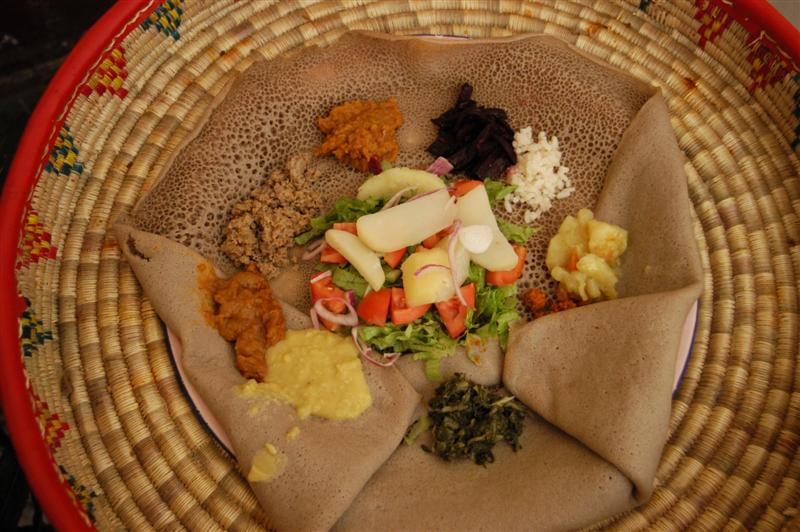 language), Ge'ez (the early Ethiopian language), and Greek. We waited and waited but there was no caretaker around to open the shack. Finally the tour group pulled up and a man with a key got out. He reluctantly let us inside the shack but couldn't argue with our tickets. Dating back to the 4th century it was well weathered but the different scripts could be made out. language), Ge'ez (the early Ethiopian language), and Greek. We waited and waited but there was no caretaker around to open the shack. Finally the tour group pulled up and a man with a key got out. He reluctantly let us inside the shack but couldn't argue with our tickets. Dating back to the 4th century it was well weathered but the different scripts could be made out.
For dinner we went to a different Ethiopian restaurant Cafe Abyssinia and since it was Friday I had the fasting plate while Rob had a burger. The food was tasty but I would live to regret that fasting plate for days afterwards. It kept me fasting for more than just one day. We stopped at the Ethiopian Air to change our flights and were lucky that the seats were now available. Talking to the teachers had convinced us that another day in Aksum and skipping Mekela was probably the wiser choice. They had heard that people were often disappointed with Melele after seeing Lalibela. Getting around Mekele would also have been expensive s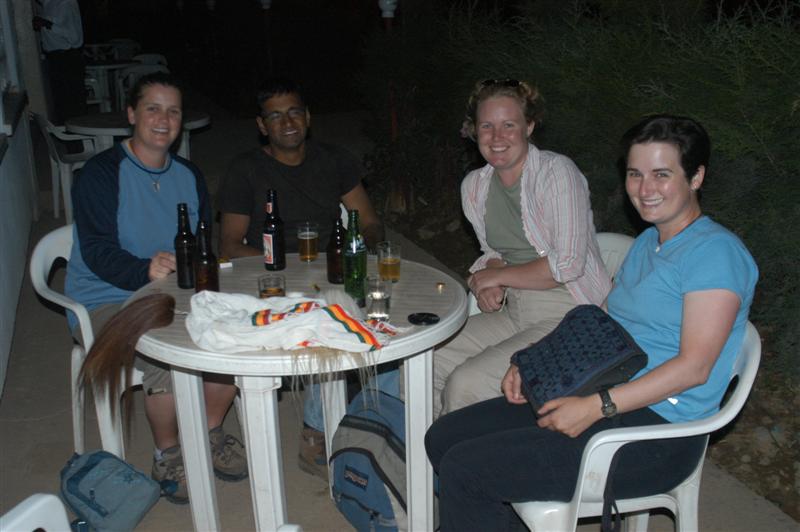 o it was an easy decision to make. After dinner we took a rest at our hotel and then caught a taxi to the Yeha Hotel to meet the teachers for drinks. The sunset wasn't spectacular but the setting was serene and we enjoyed the conversation. o it was an easy decision to make. After dinner we took a rest at our hotel and then caught a taxi to the Yeha Hotel to meet the teachers for drinks. The sunset wasn't spectacular but the setting was serene and we enjoyed the conversation. |

